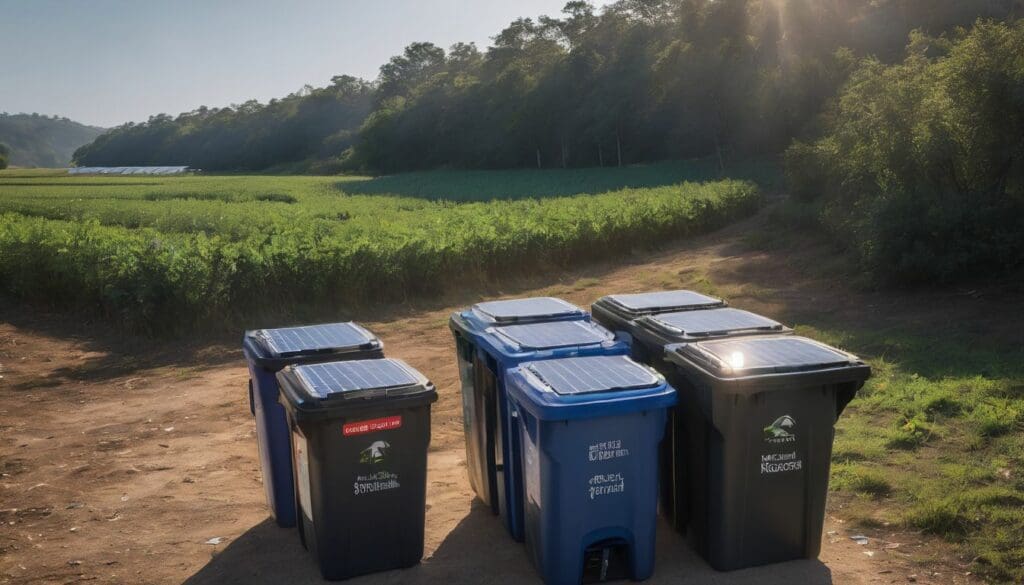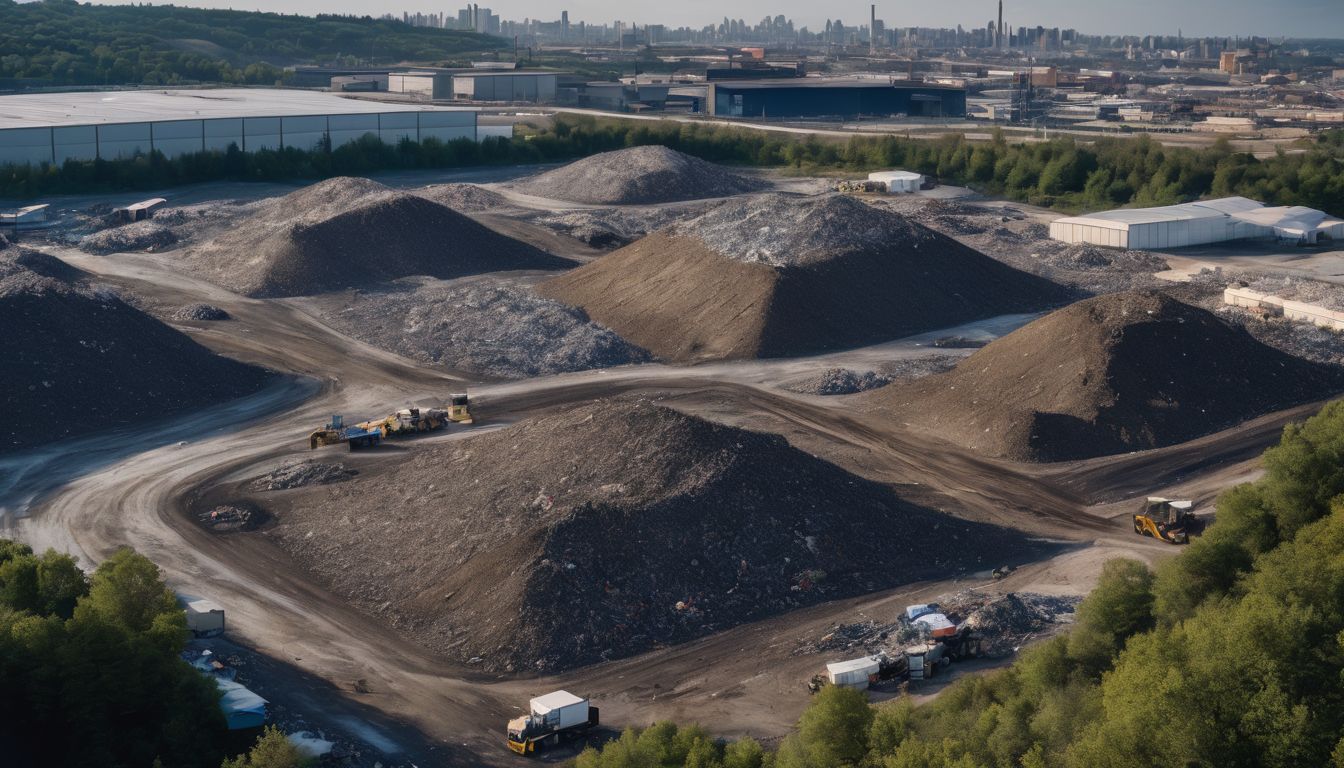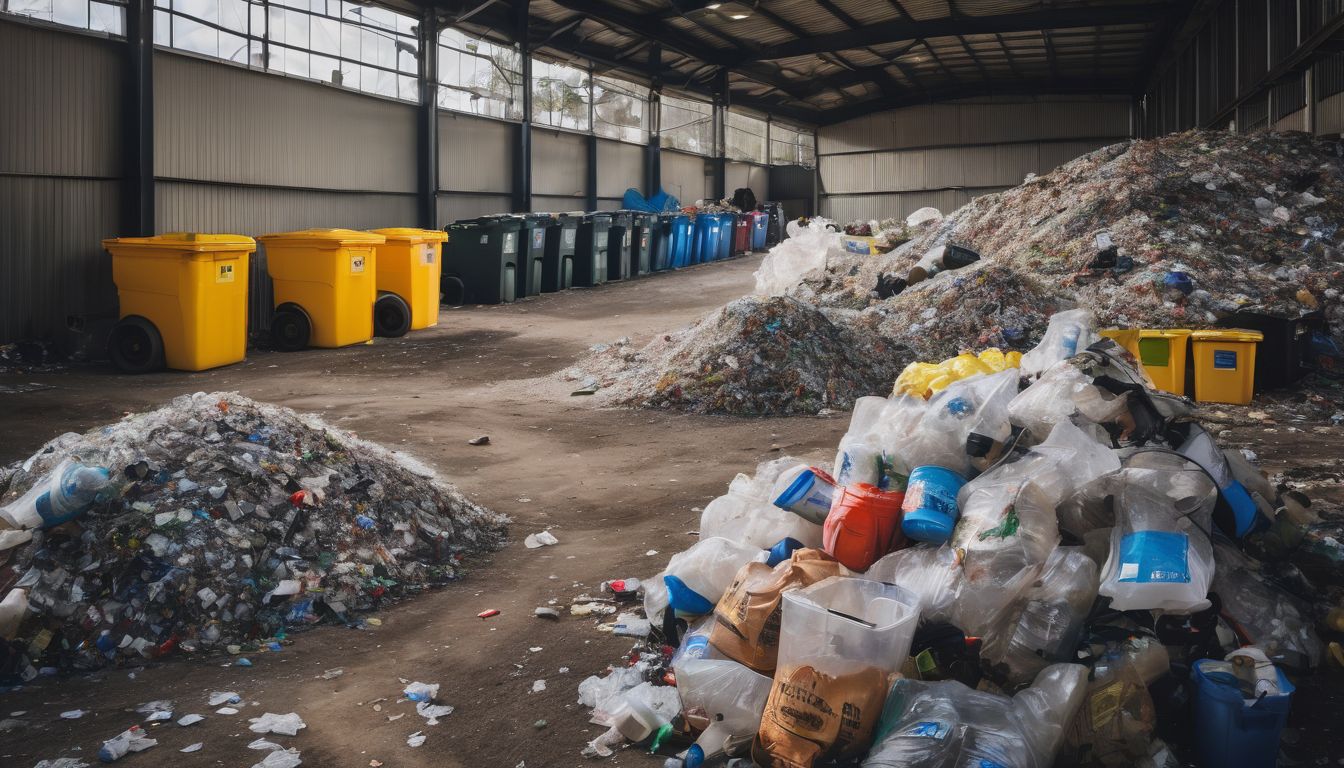Many of us worry about how we can protect the planet for future generations. It’s a little-known fact that recycling plays a crucial role in powering renewable energy sources. This article will delve into the symbiotic relationship between recycling efforts and green energy, unveiling how each supports the other in our quest for a cleaner world.
Stay with us to uncover exciting insights!
Key Takeaways
- Recycling old renewable energy infrastructure conserves valuable materials like lithium, cobalt, and rare earth metals by keeping them out of landfills, reducing the need for new mining.
- By reusing components from wind turbines and solar panels in new products, recycling supports a circular economy and aids in the transition to sustainable energy sources.
- Specialised recycling processes are essential for managing spent renewable energy equipment and contribute to environmental conservation by extending material lifecycles.
- Technological advancements in both the renewable energy sector and recycling industries improve efficiency, suggesting a promising future for sustainable practices.
- Responsible repurposing of renewable infrastructure aligns with global efforts to combat climate change by decreasing reliance on finite resources.
The Importance of Recycling for Renewable Energy
Recycling is crucial for the sustainability of renewable energy, as it allows for the recovery of valuable materials from old batteries, wind turbines, and solar panels. By keeping these materials out of landfills and closing the loop on their lifecycle, recycling plays a vital role in supporting clean energy generation.
Closing the loop on old batteries, wind turbines, and solar panels
Renewable energy technologies like wind turbines and solar panels have surged forward, reducing our carbon footprint and promoting sustainable energy generation. However, the lifecycle of their components poses a unique challenge as they wear out or become less efficient.
Innovative processes now permit us to reclaim valuable materials from spent batteries, giving them new life in fresh applications. This is more than just saving space in landfills; it’s about making the most of resources and reinforcing the principles of a circular economy.
Companies are stepping up to tackle the end-of-life phase for renewable installations by developing specialised recycling methods. Dismantling old wind turbine blades can yield fibreglass and other composites ripe for repurposing into new products.
Solar panel elements such as glass, metal framing, and silicon cells also enter a second round of usefulness after careful processing. This responsible management not only conserves natural resources but solidifies waste management as a cornerstone of environmental conservation.
Moving on from closing material loops, let’s delve into keeping these precious commodities out of our growing trash mounds.
Keeping valuable materials out of the trash
Recycling renewable energy materials keeps valuable resources out of landfills. This process preserves essential elements like lithium, cobalt, and rare earth metals needed for battery storage and solar panels.
Recovering these materials reduces the demand for mining raw resources, offering a sustainable solution to resource conservation and reducing pollution.
Recycling also supports the efficient use of energy resources by reusing valuable materials in new products. It helps mitigate climate change by decreasing the need for extracting finite resources and curtails environmental degradation from waste disposal.
The Relationship Between Recycling and Renewable Energy
Recycling sustains natural resources, reducing the need for new materials and contributing to the overall sustainability of renewable energy. The connection between renewable and recyclable materials creates a circular system that supports both environmental conservation and energy efficiency.
How recycling sustains natural resources
Recycling sustains natural resources by reducing the need for raw materials extraction. Reusing materials like metals and paper helps preserve forests, reduce energy consumption, and cut greenhouse gas emissions.
It ensures that valuable resources like water and minerals are not depleted unnecessarily. By extending the life of products through recycling, we can conserve natural resources for future generations while minimising environmental impact.
The connection between renewable and recyclable materials
Renewable materials play a crucial role in the sustainable energy transition. Incorporating recyclable elements into renewable technologies, such as wind turbines and solar panels, helps reduce the dependency on virgin resources.
By reusing materials like metals from spent infrastructure, we contribute to climate change mitigation and environmental responsibility.
Recycling empowers the circular economy by providing a continuous supply of materials for renewable energy infrastructure. This connection between recyclable and renewable materials supports eco-friendly practices, promoting clean technology and sustainable development in the pursuit of alternative energy sources.
Managing Spent Renewable Energy Infrastructure
Understanding the renewable energy market is crucial for managing spent infrastructure. It’s important to know what happens to old renewable energy infrastructure and how it can be responsibly managed.
Understanding the renewable energy market
The renewable energy market is a dynamic and rapidly growing sector. Companies are investing in wind, solar, hydroelectric, and geothermal power projects. These ecofriendly practices aim to reduce greenhouse gas emissions and reliance on non-renewable resources while harnessing the potential of renewable resources.
This shift towards renewable energy not only benefits the environment but also opens up opportunities for innovative green technology and sustainable waste management solutions.
As demand for green technology continues to rise, the renewable energy market presents new possibilities for recycling spent infrastructure. By understanding the impact of recycling in this context, environmentally conscious individuals can actively contribute to conserving natural resources and promoting a sustainable future.
What happens to old renewable energy infrastructure?
After understanding the renewable energy market, it’s essential to consider what happens to old renewable energy infrastructure. When wind turbines or solar panels reach the end of their lifespan, they can be dismantled and recycled.
The materials like steel and copper can be extracted from these structures for reuse in new products, closing the loop on valuable resources.
Moreover, batteries used in renewable energy systems can be repurposed for various applications once they are no longer suitable for energy storage. This process ensures that these spent infrastructures don’t end up in landfills, aligning with our goal of conserving natural resources and supporting environmental sustainability.
How to Recycle Spent Renewable Energy Infrastructure
Explore the various recycling and reuse options available for managing spent renewable energy infrastructure, and discover the benefits of recycling for a smooth transition to sustainable energy sources.
Exploring recycling and reuse options
Recycling and reusing spent renewable energy infrastructure is crucial for a sustainable future. Here are the options to explore:
- Repurposing old wind turbine blades for playground equipment, park benches, or even lightweight building materials.
- Recycling solar panels to recover valuable materials like silicon, glass, and aluminum for use in new products.
- Extracting rare earth elements from old batteries to be used in new energy – efficient technologies.
- Upcycling retired infrastructure components into innovative art installations or functional household items.
- Partnering with specialised recycling facilities that can dismantle and recycle complex renewable energy systems.
Benefits of recycling for the energy transition
Recycling offers significant benefits for the energy transition by conserving valuable resources. Repurposing materials from spent renewable energy infrastructure reduces the need for new raw materials in manufacturing, thus decreasing energy consumption and associated emissions.
By reusing metals and other components from old wind turbines and solar panels, recycling contributes to a more sustainable, circular economy.
Moreover, recycling supports the development of clean technologies essential for transitioning to renewable energy sources. It provides a reliable supply of critical raw materials needed for producing batteries in electric vehicles and storage systems for renewable power generation.
Conclusion
Recycling plays a critical role in the sustainability of renewable energy, helping to close the loop on old infrastructure while conserving valuable materials. As we continue to develop renewable energy technologies, recycling will be essential for creating a more sustainable future.
The role of recycling in a sustainable future
Recycling plays a crucial role in building a sustainable future by conserving natural resources and reducing environmental impact. By recycling waste products like old batteries, wind turbines, and solar panels, valuable materials are kept out of the trash, helping to close the loop on their lifecycle.
This process sustains natural resources while supporting the energy transition towards renewable sources.
Furthermore, recycling is pivotal in managing spent renewable energy infrastructure. Understanding the renewable energy market and exploring recycling options for old infrastructure not only promotes resource efficiency but also contributes to the development of a circular economy.
Future developments in renewable energy and recycling.
As we move forward, technological advancements continue to drive innovation in renewable energy and recycling. New developments in materials and processes are enhancing the efficiency and sustainability of both industries.
The integration of advanced technologies like AI, robotics, and automation is streamlining recycling processes while also improving the design and production of renewable energy infrastructure.
These innovations not only benefit the environment but also contribute to a more circular economy where resources are conserved and utilised efficiently.
FAQs
1. What is the connection between recycling and renewable energy?
Recycling materials can save energy, reducing the need for producing new items from scratch, which often uses non-renewable resources.
2. How does using recycled materials help with renewable energy?
Using recycled materials lessens our reliance on fossil fuels by cutting down the amount of new raw resources extracted and processed, usually requiring more energy.
3. Can recycling contribute to creating renewable energy sources?
Yes, some waste products from recycling can be converted into biofuels or biomass for generating electricity, thus becoming a form of renewable energy.
4. Why should we consider both recycling and renewable energy together?
Considering both helps us manage waste better and reduce carbon emissions from traditional energy sources, supporting a sustainable future through cleaner methods of production and consumption.





